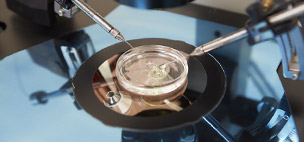Intracytoplasmic Sperm Injection (ICSI)
Reaching the fertilization in cases of male infertility
High complexity medical treatments
ICSI in Mexico with high pregnancy rates
Intracytoplasmic sperm injection (ICSI) is the procedure in which one sperm is injected directly in the cytoplasm of the egg. This technique is used when the sperm analysis male infertility reports: astenozoospermia when the motility is altered by low sperm movement (less than 50% according to WHO parameters); teratozoospermia, with altered morphology and abnormal sperm forms (less than 4% according to Kruger’s strict criteria); oligozoospermia, when concentration per sample is lower than 15 million/mL. When is lower than this figure, is considered criptozoospermia. Egg fertilization is performed mechanically at our labs inmovilizing one sperm through aspiration in order to micro inject the sperm in the center of each egg.
For whom is this technique indicated?
Mainly when the following conditions preexist:
- Men with previous vasectomy.
- Men with low motility or low morphology sperm samples.
- Cryopreserved sperm samples.
- Difficulties for normal ejaculation.
- After several unsuccessful IVF results.
- In cases of female factor infertility and ovulation issues.

Process
The steps to follow through intracytoplasmic sperm injection (ICSI) are basically the same that we perform for conventional IVF, with the particularity that egg fertilization is performed through the artificial introduction (micro injection) of the sperm to each retrieved egg.
Our Process
The step by step guide of our IVF Mexico procedure

1. Ovarian stimulation

2.Punction, retrieval and aspiration

3. Fertilization through ICSI

4. Embryo culture

5. Embryo transfer
When the embryo is at its best moment to implant on the woman’s uterus, is places inside the uterus on its distal locus (near the Fallopian tubes) to start its development and furthermore, to carry a pregnancy. This is performed by charging the embryos on a cannula that is conducted trans-vaginally until it reaches the uterus. An embryo or two may be transferred, according to each particular case.







